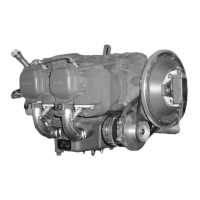SECTION 5 LYCOMING OPERATOR’S MANUAL
MAINTENANCE PROCEDURES O-320 SERIES
NOTE
When installing valve springs, place the dampener end of spring (close wound coils marked
with dye or lacquer) toward the cylinder.
Using a valve spring compressor, compress the valve springs and place the split keys in the groove
around the upper end of the valve stem. Slowly release the pressure on the valve spring compressor
and allow the upper spring seat to lock itself in place around the valve keys.
d. Assembly of Cylinder and Related Parts – Rotate the crankshaft so that the connecting rod of the
cylinder being assembled is at the top center position that corresponds with both valves closed.
(1) Place each plunger assembly in its respective tappet body and assemble the socket on top of
plunger assembly.
(2) Assemble piston with rings so that the cylinder number stamped on the piston pin boss is toward
the front of the engine. The piston pin should be a handpush fit. If difficulty is experienced in
inserting the piston pin, it is probably caused by carbon or burrs in the piston pin hole. During
assembly, always use a generous quantity of oil, both in the piston hole and on the piston pin.
(3) Assemble one piston pin plug at each end of the piston pin and place a new rubber oil seal ring
around the cylinder skirt. Coat piston and rings and the inside of the cylinder generously with oil.
(4) Using a piston ring compressor, assemble the cylinder over the piston so that the intake and
exhaust ports are at the bottom of the engine. Push the cylinder all the way on, catching the ring
compressor as it is pushed off.
NOTE
Before installing cylinder hold-down nuts, lubricate crankcase thru-stud threads with any
one of the following lubricants, or combination of lubricants.
1. 90% SAE 50W engine oil and 10% STP.
2. Parker Thread Lube.
3. 60% SAE 30W engine oil and 40% Parker Thread Lube.
(5) Assemble hold-down plates (where applicable) and cylinder base hold-down nuts and tighten as
directed in the following steps.
NOTE
At any time a cylinder is replaced, it is necessary to retorque the thru-studs on the cylinder
on the opposite side of the engine
(a) Engines Using Hold-Down Plates – Install shims between cylinder base hold-down plates
and cylinder barrel, as directed in Figure 5-3, and tighten ½ inch hold-down nuts to 300 in.-
lbs. (25 ft.-lbs.) torque, using the sequence shown in Figure 5-3.
(b) Remove shims, and using the same sequence, tighten the ½ inch cylinder base nuts to 600
in.-lbs. (50 ft.-lbs.) torque.
NOTE
Cylinder assemblies not using hold-down plate are tightened in the same manner as above
omitting the shims.
5-8

